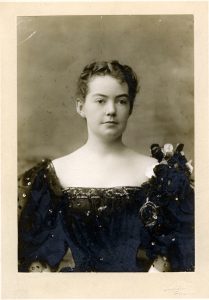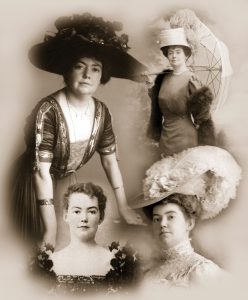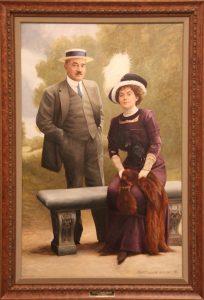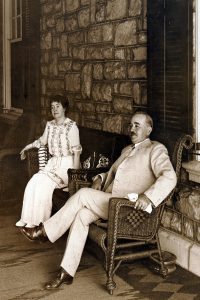It Was Kitty’s Idea
The Milton Hershey School, located in Hershey, Pennsylvania, began as a dream and vision shared by chocolate magnate Milton Hershey and his wife, Catherine. Unable to have children of their own, the Hersheys decided to use their wealth to create a home and school for orphaned boys. Established on November 15, 1909, the first students of what was then known as the Hershey Industrial School lived and attended class in the Homestead, the rural birthplace of Milton Hershey. Here they were provided with a stable home life and a rigorous combination of agricultural, vocational, and academic learning. When pressed by others for an explanation of why they started their school, Milton Hershey would simply and matter-of-factly state, “It was Kitty’s idea.”
 Catherine Elizabeth (Kitty) Sweeney was born on July 6,1872, in Jamestown, New York. The future Mrs. Hershey was the oldest of four children born to Irish immigrants Michael William Sweeney of County Cork and Catherine Elizabeth Maloney of County Clare. An attractive woman with a bubbly and warm personality, she attended Jamestown High School, but did not graduate. Instead she decided to leave during her senior year to work to help support her family.
Catherine Elizabeth (Kitty) Sweeney was born on July 6,1872, in Jamestown, New York. The future Mrs. Hershey was the oldest of four children born to Irish immigrants Michael William Sweeney of County Cork and Catherine Elizabeth Maloney of County Clare. An attractive woman with a bubbly and warm personality, she attended Jamestown High School, but did not graduate. Instead she decided to leave during her senior year to work to help support her family.
It was in Jamestown, then a prominent center of commerce and trade, that Catherine met Milton Hershey. Milton often visited Jamestown to promote his products and acquire new orders or to pass through on his way to his manufacturing plant in Chicago. After a year-long courtship, the Hersheys were married in the rectory of St. Patrick’s Cathedral in New York City on May 25, 1898.
After her marriage, Catherine moved to Milton’s home in Lancaster. At that time, the Hershey Chocolate Company was located in Lancaster, where the bulk of production would remain until completion of a new factory in Hershey in 1905. Prior to meeting Catherine, Milton Hershey had lived the carefree life of the Victorian bachelor. It is only after his marriage that Milton began to show an interest in philanthropy. For instance, in 1900 in what was perhaps the earliest example of Hershey’s new-found generosity, Milton gave a gift of $5,000 to Lancaster’s Franklin and Marshall College for the outfitting of a chemical laboratory in the new Science Building.
Not long after, Catherine saw to it that the Diocese of Harrisburg, of which Lancaster was a part, received a sizable gift toward construction of a new Cathedral of St. Patrick in the state capital. The Diocese began construction on the Cathedral in March 1904 and dedicated the finished building in June 1907. A practicing Catholic for most of her life, the Diocese officially recognized Catherine as a benefactor of the Cathedral by including the name of Mrs. M.S. Hershey on the list of founders inscribed on a wall located just inside the main entrance.
 While in Lancaster, Catherine Hershey actively participated in the Lancaster Charity Society, an organization devoted to aiding the poor families and children of Lancaster City. Organized March 1, 1904, the Society dedicated itself to “the elevation of the moral and physical condition of the indigent, and for the relief of their necessities.” A large part of the Society’s work with families in need was spent in finding homes for homeless and deserted children. The Society’s first annual report (1904-1905) and second annual report (1906-1907) list Mrs. M.S. Hershey as a member of the organization’s Conference Committee.
While in Lancaster, Catherine Hershey actively participated in the Lancaster Charity Society, an organization devoted to aiding the poor families and children of Lancaster City. Organized March 1, 1904, the Society dedicated itself to “the elevation of the moral and physical condition of the indigent, and for the relief of their necessities.” A large part of the Society’s work with families in need was spent in finding homes for homeless and deserted children. The Society’s first annual report (1904-1905) and second annual report (1906-1907) list Mrs. M.S. Hershey as a member of the organization’s Conference Committee.
This committee met every Monday morning to both direct and supervise the work of the Society as described in their first annual report:
When a case of destitution or need is reported, it is immediately investigated by the Executive Officer and, if worthy temporary assistance and relief will at once be provided. The case is then taken up by the Conference Committee, and they give it study and attention, and not only is relief provided, but the case of the poverty is sought out, and efforts made to eradicate the cause of the distress, and employment is procured whenever possible.
The goal of the Lancaster Charity Society was to provide practical self help and aid to the poor of Lancaster. Obviously, that work could not be undertaken without monetary contributions and in-kind donations. Realizing this, Catherine immediately joined as one of seven inaugural life members. These individuals are defined as “any person who shall contribute to the Society not less than one hundred dollars in any one year.” Of the other six life members listed in the first annual report of the Society, one name in particular stands out – then Lancaster resident and well know five-and-dime store founder F. W. Woolworth. Catherine remained on the list as a life member through the eleventh annual report (1914-1915), when she is marked as deceased.
 As the wife of Mr. Milton S. Hershey, Catherine was expected to both entertain her husband’s personal acquaintances and business associates as well as supervise the domestic side of their lives. As such, she traveled the world with her husband and also involved herself in overseeing construction and landscaping of their new home in Hershey. Catherine especially enjoyed supervising the interior design for their home, selecting vibrant hues of blue and green for the guest rooms, pink for her own room, and blue for her husband’s.
As the wife of Mr. Milton S. Hershey, Catherine was expected to both entertain her husband’s personal acquaintances and business associates as well as supervise the domestic side of their lives. As such, she traveled the world with her husband and also involved herself in overseeing construction and landscaping of their new home in Hershey. Catherine especially enjoyed supervising the interior design for their home, selecting vibrant hues of blue and green for the guest rooms, pink for her own room, and blue for her husband’s.
She also took special pride in the beautifully landscaped grounds of High Point which were open to the public. Located as it was in close proximity to the chocolate factory, High Point was very much a part of the Hershey community. Completed in 1908, the Hersheys modestly furnished their new home and took special care to populate it with many of the items they purchased on their many trips together.
The completion of High Point and the permanent relocation of the Hersheys from Lancaster to Hershey that same year ushered in a new chapter in the philanthropic lives of the couple. Catherine’s work with the Lancaster Charity Society prepared her well to influence both the course of instruction as well as the overall philosophy of the Hershey Industrial School. Catherine worked closely with Prudence Copenhaver, wife of school superintendent George Copenhaver, in planning the home life program – including menus, clothing, social skills, and all the other things she wanted the boys to learn.
 Catherine combined her love of gardens with her love of children by having the boys to breakfast at High Point. As the debilitating disease which would eventually take her at the young age of 42 worsened, Catherine became increasingly uncomfortable and unsure of herself in public. Breakfast at High Point became a special treat for the boys, and their visits allowed Catherine to see for herself that they were being properly attended to and cared for in accordance with her wishes and desires.
Catherine combined her love of gardens with her love of children by having the boys to breakfast at High Point. As the debilitating disease which would eventually take her at the young age of 42 worsened, Catherine became increasingly uncomfortable and unsure of herself in public. Breakfast at High Point became a special treat for the boys, and their visits allowed Catherine to see for herself that they were being properly attended to and cared for in accordance with her wishes and desires.
Catherine Hershey suffered from a debilitating disease of the nervous system, which she fought with courage and her usual positive nature until her death on March 25, 1915. Though the disease had manifested itself early in their marriage, the last few years of her life proved to be the most painful and difficult. In an effort to find relief, Catherine spent increasing amounts of time in Europe to visit both specialists and spas. By the end of 1914, she was nearly completely incapacitated. When her doctors could do nothing more for her, she turned to Christian Science as a means of comfort and support.
Milton Hershey never remarried, and he carried a picture of Catherine with him everywhere he went until his own death in 1945. He spent the remaining 30 years of his life focused on expanding his company to the benefit of the Milton Hershey School.
Today, the School continues the tradition of preparing students to lead productive and fulfilling lives by providing a cost-free, private, coeducational home and school for children of families of low income-just as first envisioned by Milton and Catherine Hershey over 100 years ago.
This article was first published in the Spring 2010 Women-CONNECT magazine when Catherine Hershey was posthumously given the Coretta Scott King Women for Diversity Award.

